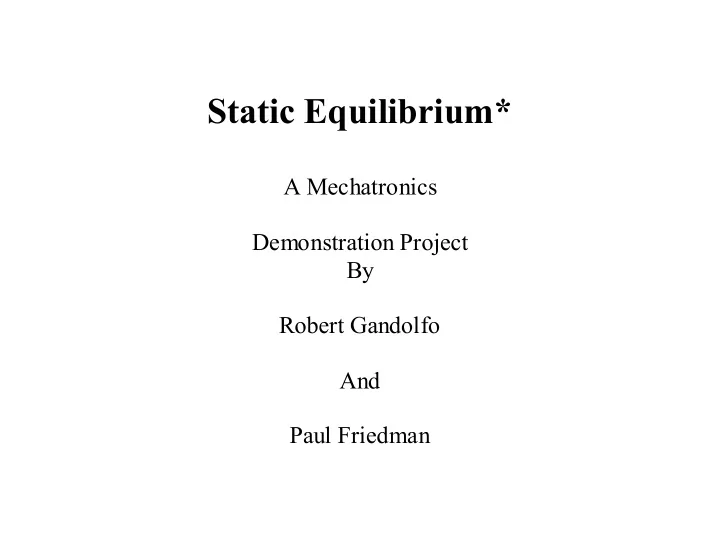

Static Equilibrium* A Mechatronics Demonstration Project By Robert Gandolfo And Paul Friedman
Abstract The intent of this project is to provide a visual demonstration of a standard static equilibrium problem that high school physics students are responsible for. The use of servomotors, sensors and basic programming further demonstrates how concepts of physics, mechanical engineering, electrical engineering and computer programming are interrelated and interdependent. This project provides students with a model of a real world problem in which concepts they are learning in school are applied.
STATIC EQUILIBRIUM • STANDARD PHYSICS T PROBLEM α • NO MOTION F H θ x • Σ FORCES = 0 W3 W2 W1 • Σ TORQUE = 0 F V
SENSORS & DRIVES • TWO SERVO MOTORS • ROTARY POTENTIOMETER • SLIDE POTENTIOMETER • LOAD CELL • LEAD SCREW
ELECTRONICS • TWO ADC 0831 CHIPS – SENSE VOLTAGE • BREADBOARD – RESISTOR/CAPACITOR • PARALLAX BS2 CHIP • PBASIC CODE
ELECTRICAL SCHEMATIC Vdd Vdd P3 Incline ADC P4 sensor 0831 Vdd P5 Vdd Offset
LOAD CELL Vdd 0.01 ? F 220 ? P13 FlexiForce #A101
OPERATION • INPUT – BOOM ANGLE θ (5 TO 55 DEG) T – SLIDE WEIGHT POSITION α – 17 TO 22 CM FROM PIVOT • FEEDBACK F H θ x W3 – BOOM ANGLE W2 W1 – SLIDE POSITION F V – CABLE TENSION • CALCULATE – CABLE ANGLE – REACTION FORCES
CALCULATIONS Σ τ = 0 • Σ τ = T L 3 sin( α + θ ) - W 1 L 1 cos • T θ – W 2 L 2 cos θ – W 3 L 3 cos θ α Σ F x = 0 • Σ F x = F H – T cos α • Σ F y = 0 • F H θ x W3 Σ F y = F V - W 1 - W 2 – W 2 + T • W2 W1 sin α F V
APPLICATIONS • MODEL – ELBOW – KNEE – CRANE – BRIDGE – BACKHOE
THANK YOU ! • Sang Hoon Lee • Yvonne Lee • Saul Harari • Hong Li • Imran Ahmed • NSF (022749) • Prof. V.Kapila
Recommend
More recommend